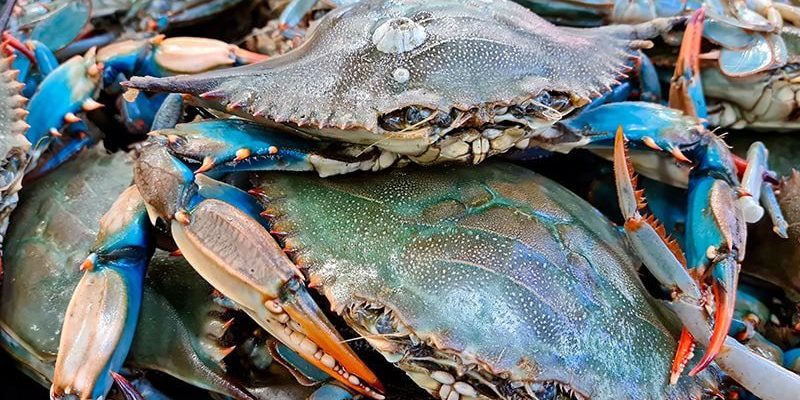![Blue Crab Vs. [Similar Species] - Key Differences](https://gudri.com/wp-content/uploads/2025/06/Blue_Crab_Vs___Similar_Species______Key_Differences_image_0.jpg)
So, let’s dive into the world of crabs and explore how the blue crab stacks up against its closest relatives, such as the Jonah crab and the Dungeness crab. You might be surprised by what you learn!
Identifying Features: What Makes a Blue Crab Unique?
Blue crabs, scientifically known as *Callinectes sapidus*, are famous for their striking blue color, especially the claws. This vibrant hue comes from pigments in their shells, which can change based on their environment. Typically, a blue crab’s shell is olive green with a hint of blue, making them quite the visual treat when they scuttle across the sandy bottom.
But there’s more to their appearance than just a pretty shell. Blue crabs have long, thin legs that help them swim quickly and navigate through their environments. They can grow up to 9 inches across, and their claws are equipped with sharp spines, making them formidable predators in their habitats. These features not only aid in their survival but also play a role in their popularity among fishermen.
Color Variations Across Species
Now, if you put a Jonah crab next to a blue crab, you might notice some significant differences. Jonah crabs have a more subdued coloring—typically a dark brown or greenish hue. Their claws are also less pronounced, lacking the vibrant blue that adds flair to blue crabs. In contrast, the Dungeness crab, with its sleek, tan shell and wide body, provides yet another distinct look.
Key differences in coloring can help you identify these species:
- Blue Crab: Bright blue claws, olive-green body.
- Jonah Crab: Dark brown or greenish shell.
- Dungeness Crab: Tan shell with a smooth, rounded shape.
Habitat and Range: Where Do They Live?
Blue crabs are primarily found along the Atlantic coast, from Maine down to Florida. They thrive in brackish waters—those salty mixes of ocean and freshwater found in estuaries and bays. These environments provide plenty of food, like small fish and mollusks, which helps sustain their populations.
In contrast, Jonah crabs prefer colder, deeper waters along the Atlantic, especially around New England. You’ll often find them on rocky or sandy seabeds, where they can easily burrow and feed. The Dungeness crab resides mainly on the West Coast, from Alaska down to California, favoring sandy bottoms in bays and estuaries, which makes it a staple of Pacific seafood cuisine.
Why Habitat Matters
Understanding the habitat of each species is crucial, especially for fishing enthusiasts. If you’re searching for blue crabs, you’ll likely want to explore areas near marshes or estuaries during warmer months. For Jonah or Dungeness crabs, your fishing spots would be quite different.
Life Cycle Differences: How They Grow
The life cycle of blue crabs is fascinating. Females typically spawn in the warmer months, releasing thousands of eggs into the ocean. After hatching, the tiny larvae drift in the currents before settling into estuaries, where they grow into juvenile crabs. It usually takes about two to three years for blue crabs to reach maturity.
Jonah crabs, on the other hand, have a shorter growth cycle but a similar reproductive strategy. They spawn earlier in the spring, and their larvae also drift before settling. Dungeness crabs have a longer life cycle, often taking about three to five years to mature.
Growth Implications
The differences in growth rates can affect their availability in local markets. For example, blue crabs tend to be more abundant in the late summer and early fall, while Dungeness crabs can be caught throughout the year, depending on local regulations.
Taste and Culinary Uses: Which One’s the Best?
Let’s be honest: when it comes to crabs, taste is a big part of the equation! Blue crabs are known for their sweet, tender meat, often enjoyed in crab cakes or simply steamed with butter. Their meat has a distinctive flavor, often described as rich and nuanced, which can elevate any dish.
Jonah crab meat tends to be a bit firmer and has a slightly sweeter taste than blue crabs. It’s often used in dishes that benefit from a meatier texture, like crab soups and stews. On the other hand, Dungeness crabs are a favorite on the West Coast, known for their mild and slightly sweet flavor. They’re often served whole with melted butter and lemon, making for a delightful dining experience.
Culinary Comparisons
When choosing the right crab for your recipe, consider the flavor and texture:
- Blue Crab: Sweet, tender, great for crab cakes.
- Jonah Crab: Firm, sweet, ideal for hearty soups.
- Dungeness Crab: Mild, sweet, perfect for simply steaming.
Conservation and Sustainability: Protecting Crab Populations
Considering the environmental impact of harvesting these crabs is essential. Blue crab populations can fluctuate based on fishing pressures and environmental factors. They’re often managed through regulations that limit catch sizes and seasons, ensuring that their populations remain healthy.
Similarly, Jonah crabs are subject to regulations meant to protect their stocks. Because of their slower growth rates, they require careful management to avoid overfishing. Dungeness crabs also face similar challenges, but they have robust management practices in place to ensure sustainability, especially in California.
The Importance of Conservation
Supporting sustainable crab fisheries is crucial not just for the crabs but for the entire ecosystem. You might be wondering how to ensure you’re making sustainable choices. Look for seafood certifications or local sources that prioritize responsible fishing practices.
Understanding the differences between the blue crab and similar species like the Jonah and Dungeness crabs is not just about biology—it’s also about your culinary choices and enjoying these delicious seafood options responsibly. Whether you lean towards the sweet, tender meat of a blue crab or the firm, flavorful bites of a Jonah crab, each species adds something unique to your plate.
So, next time you’re at the seafood counter or planning a fishing trip, remember these differences. Choose wisely, and you’ll ensure a satisfying and sustainable crab experience that’s sure to impress your dinner guests!

